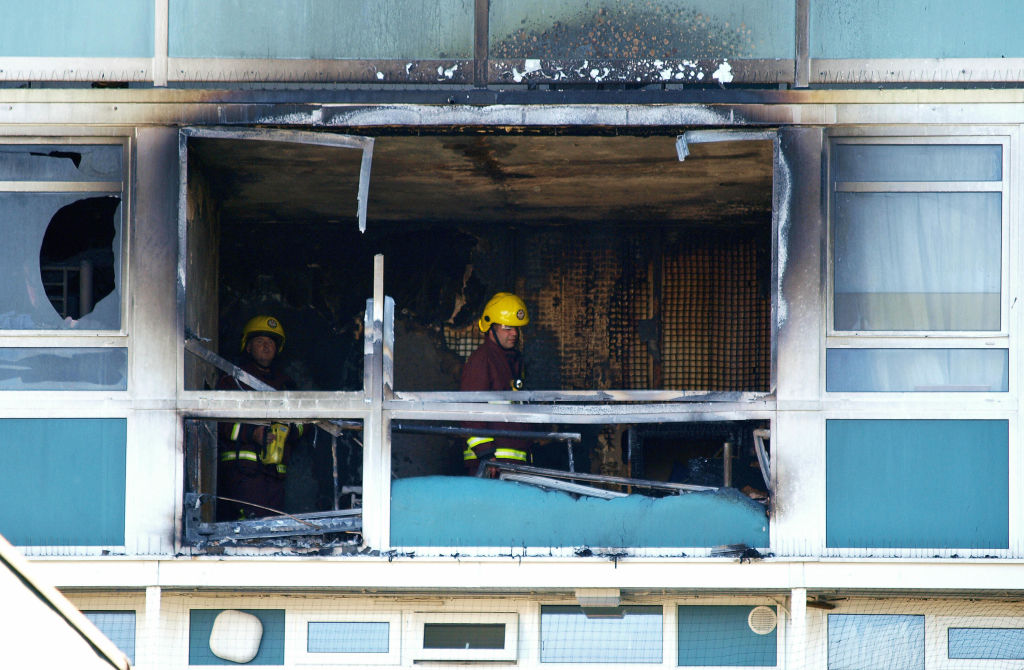The Number 10 Christmas parties during lockdown have dominated the news agenda in recent days – and for good reason. But there has arguably been an even bigger government scandal brewing, one which has largely been overlooked in Westminster.
On Tuesday the government told the Grenfell Tower Inquiry that it was ‘deeply sorry’ for the ‘past failures’ which contributed to the devastating 2017 fire which killed 72 people.
Apologies always come in varying forms of breadth and sincerity and this one (as is often the case when delivered by an expensive QC) was carefully limited. The government said that it had assumed fire regulations were being monitored ‘at a local level’ and that it had failed to oversee properly the town halls responsible for enforcing the rules. It also said it had a ‘misplaced trust’ in product suppliers and contractors and this faith was ‘abused’.
It did not take a particularly exacting legal mind to realise that this particular framing of the Grenfell disaster seems to relieve government of any direct responsibility. The government has failed, in this reading, only to stop the failures of others.
Indeed, the government’s lawyer asserted that ‘had the building regulations, British standards and statutory guidance been followed, a large-scale cladding fire could not have happened.’
This claim and limited apology simply do not match the staggering scale of state failure which has emerged since the fire and was drawn out in detail by lawyers acting for the survivors this week.
This limited apology simply does not match the staggering scale of state failure which has emerged since the fire
The allegation is not that the government innocently sat back and trusted local councils to enforce a perfectly good set of rules, but that it knew the risks of dangerous cladding for three decades, deliberately covered them up and reduced the existing protections in the name of deregulation.
In 1991, a fire ripped through a cladding system at a Merseyside tower block. The government had paid for this system and was monitoring it as a pilot to be rolled out elsewhere.
A handwritten note from the time suggests officials requested the fire be ‘played down’ and a report into the blaze was stamped ‘limited circulation’ and never made public. If it had, it would have revealed the block used combustible plastic cladding panels and combustible window frames in a startlingly similar configuration to the system installed on Grenfell 25 years later.
In 1999, a report into a second fire – this time in Scotland – was also hushed up. Following the recommendation of a select committee investigating both of these blazes, the government decided to set up a process of large-scale testing to assess the danger of cladding systems.
This led to a trial period where it ran mock tests on a series of popular cladding systems to see how efficiently this test worked in 2002.
These included a cladding system with polyethylene-cored aluminium cladding panels – precisely the material later used on Grenfell.
It failed devastatingly badly – the test had to be terminated less than six minutes into its 30 minute duration. A lawyer for one group of survivors this week said it ‘beggars belief’ that this material was not ‘expressly prohibited’ following this result.
It was not. In fact, tougher European fire standards for cladding were not picked up in the UK, with an official report fretting that they would ‘discriminate’ against some popular products.
Arconic, the company which sold the panels for use on Grenfell, would notice this regulatory weakness, writing internally that it could still sell its panels here ‘even if we know [it] has a bad behaviour exposed to fire’.
In 2009 the risks of this regulatory weakness were laid bare when a fire at Lakanal House in south London spread over combustible wall panels, killing six people.
The London Fire Brigade advised the government that the panels on the building were dangerous and may have been used elsewhere. It suggested warning housing providers to check their buildings. The government refused.
Not only that, it moved to shut down the investigation with officials saying they wanted to ‘avoid giving impression that we believe all buildings of this construction are inherently unsafe.’ Lawyers this week said this ‘raised the spectre of a deliberate cover up’.

Warnings continued to land during the 2010s, particularly as huge cladding fires ripped through buildings in the Middle East. But the government not only failed to act it also waved through industry guidance which allowed builders to use combustible systems which had never been tested so long as they could get a report from a consultant assuring that it was safe.
The allegation is that the government was so desperate to limit regulatory burdens on house builders that it simply could not countenance toughening rules.
This is not hard to believe. Anyone who remembers the coalition era will remember the triumphalism about ‘reducing red tape’ and ‘killing health and safety culture’. This emphasis meant civil servants simply could not countenance bringing in necessary safety measures. None of this was addressed by the government’s apology this week.
The crisis this caused also stretches beyond Grenfell Tower. To those living in flats clad with similarly dangerous material, any apology will ring hollow while they are still cruelly made to pick up the tab for fixing the mess.
As the evidence of this section of the inquiry spins out over the coming weeks, that is a position that will be increasingly difficult to maintain.





Comments